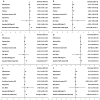The Effect of Individual Attitude toward Healthy Nutrition on Adherence to a High-UFA and High-Protein Diet: Results of a Randomized Controlled Trial
- PMID: 39275358
- PMCID: PMC11397022
- DOI: 10.3390/nu16173044
The Effect of Individual Attitude toward Healthy Nutrition on Adherence to a High-UFA and High-Protein Diet: Results of a Randomized Controlled Trial
Abstract
Despite beneficial cardiovascular effects, substantial long-term modulation of food pattern could only be achieved in a limited number of participants. The impact of attitude towards healthy nutrition (ATHN) on successful modulation of dietary behavior is unclear, especially in the elderly. We aimed to analyze whether the personal ATHN influences 12-month adherence to two different dietary intervention regimes within a 36-month randomized controlled trial.
Methods: 502 subjects were randomized to an intervention group (IG; dietary pattern focused on high intake of unsaturated fatty acids (UFA), plant protein and fiber) or control group (CG; dietary recommendation in accordance with the German Society of Nutrition) within a 36-month dietary intervention trial. Sum scores for effectiveness, appreciation and practice of healthy nutrition were assessed using ATHN questionnaire during the trial (n = 344). Linear regression models were used to investigate associations between ATHN and dietary patterns at baseline and at month 12.
Results: Retirement, higher education level, age and lower body mass index (BMI) were associated with higher ATHN sum scores. ATHN was similar in CG and IG. Higher baseline intake of polyunsaturated fatty acids (PUFA) and fiber as well as lower intake in saturated fatty acids (SFA) were associated with higher scores in practice in both groups. The intervention resulted in a stronger increase of UFA, protein and fiber in the IG after 12 months, while intake of SFA declined (p < 0.01). Higher scores in appreciation were significantly associated with higher intake of fiber and lower intake of SFA in the CG at month 12, whereas no associations between ATHN and macronutrient intake were observed in the IG after 12 months.
Conclusions: While ATHN appeared to play a role in general dietary behavior, ATHN did not affect the success of the specific dietary intervention in the IG at month 12. Thus, the dietary intervention achieved a substantial modification of dietary pattern in the IG and was effective to override the impact of the individual ATHN on dietary behavior.
Keywords: attitude; healthy aging; healthy nutrition.
Conflict of interest statement
The authors declare no conflicts of interest.
Figures



References
-
- Afshin A., Sur P.J., Fay K.A., Cornaby L., Ferrara G., Salama J.S., Mullany E.C., Abate K.H., Abbafati C., Abebe Z., et al. Health Effects of Dietary Risks in 195 Countries, 1990–2017: A Systematic Analysis for the Global Burden of Disease Study 2017. Lancet Lond. Engl. 2019;393:1958–1972. doi: 10.1016/S0140-6736(19)30041-8. - DOI - PMC - PubMed
-
- Kurihara A., Okamura T., Sugiyama D., Higashiyama A., Watanabe M., Okuda N., Kadota A., Miyagawa N., Fujiyoshi A., Yoshita K., et al. Vegetable Protein Intake Was Inversely Associated with Cardiovascular Mortality in a 15-Year Follow-Up Study of the General Japanese Population. J. Atheroscler. Thromb. 2019;26:198–206. doi: 10.5551/jat.44172. - DOI - PMC - PubMed
-
- Nabuco H.C., Tomeleri C.M., Junior P.S., Fernandes R.R., Cavalcante E.F., Nunes J.P., Cunha P.F., dos Santos L., Cyrino E.S. Effects of Higher Habitual Protein Intake on Resistance-Training-Induced Changes in Body Composition and Muscular Strength in Untrained Older Women: A Clinical Trial Study. Nutr. Health. 2019;25:103–112. doi: 10.1177/0260106019838365. - DOI - PubMed
Publication types
MeSH terms
Substances
Grants and funding
LinkOut - more resources
Full Text Sources

